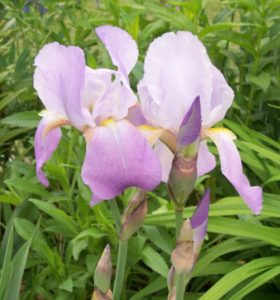It’s Still Just Dirt, The Tillsonburg News – August 2019
by Angela Lassam
During a walk round the garden I noticed it is becoming crowded. I am guessing it is time to consider working on the early flowering perennials. They need digging up, splitting and replanting or sharing with fellow gardeners.
There are two in particular that have distinct treatment. These are lilies and the bearded iris.
Asiatic and oriental lilies are bulbs that naturalize over time similar to any spring bulb. It is suggested to keep a profusion of blooms. You need to lift the area of the original bulb where you will find several bulblets and larger bulbs, these will give you new flowers. When the plant is turning yellow the naturalization has been completed for the year and you can do your separating. Planting is the same as spring bulbs. Place the bigger bulbs 6” in the soil and smaller ones not so deep. A clump of three or more makes for a good display. Add extra mulch over new planting to add insulation for the winter.
Daylilies are not bulbs but a root with fanlike sections of growth. A clump of daylilies with a dead centre is a sign of needing division. It is suggested to separate every two to three years for maximum blooms. Lift the root ball carefully and shake off as much soil as possible. This is when you will see the fanlike sections. Carefully pull them apart keeping three fans with roots for replanting. A hole at least 12” deep is needed and a mound left in the centre. Take the new root ball and spread the roots around the mound. Fill in making sure to leave no air pockets. A deep watering of manure tea will finish the task and help the plant establish before winter.
Bearded iris are rhizomes and should be divided every two to three years, otherwise they will slowly flower less. The rhizomes will work to the top of the soil and rot and borer damage will occur. Gather together tools – fork or spade, hose for rinsing, scissors, knife or pruners and a tarp for easy cleanup. Using a spade or fork carefully lift all of the clump. Clean off all soil first by shaking and then using a garden hose. This will allow you to inspect for any damage. At this time you can cut the foliage down to 6” to make easier handling. Borer damage is tiny holes in the rhizome and the leaves may have dark streaks in them. Any soft spots are a sign of soft rot. Both of these need to be cut out with pruners or a sharp knife. Disinfect tools after doing this. Now you can split the rhizome to make new plants. You will have several leaf fans on the rhizome and you need one fan and a good piece of rhizome each side. Take the knife or pruners and cleanly dissect it making several new plants. Next is soil preparation. The hole does not need to be deep as Iris do not like to be far below the surface. The hole will need a mound for the rhizome to “sit” on to keep it just below the surface. Place the rhizome on the mound spreading the roots around. Top up with soil and water well. They do not need fertilizer unlike lilies.
This gardening task is best done in the morning so moisture loss is at a minimum. You will be rewarded next year with better flowers and a tidier looking flower bed. As a bonus you will have many plants to share as you will not need them, or maybe start another flower bed!
Monthly meetings for the Tillsonburg Horticultural Society will resume on Tuesday, September 3rd @ 7:30 p.m. in the Senior Centre, Tillsonburg Community Centre. Speaker is Nick Vanderheide of Creekside Growers talking about his dahlia operation. Regular members and new always welcome. Refreshment and social time for all.
